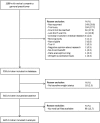Differences in respiratory consultations in primary care between underweight, normal-weight, and overweight children
- PMID: 31053706
- PMCID: PMC6499776
- DOI: 10.1038/s41533-019-0131-0
Differences in respiratory consultations in primary care between underweight, normal-weight, and overweight children
Abstract
This prospective cohort study investigates whether the suggested association between weight status and respiratory complaints in open populations is also reflected in the frequency of consultations for respiratory complaints at the general practice. Children aged 2-18 years presenting at one of the participating general practices in the Netherlands could be included. Electronic medical files were used to extract data on consultations. Logistic regression analyses and negative binomial regression analyses were used to assess the associations between weight status and the presence, and frequency of respiratory consultations, respectively, during 2-year follow-up. Subgroup analyses were performed in children aged 2-6, 6-12, and 12-18 years old. Of the 617 children, 115 (18.6%) were underweight, 391 (63.4%) were normal-weight, and 111 (18%) were overweight. Respiratory consultations were not more prevalent in underweight children compared to normal-weight children (odds ratio (OR) 0.87, 95% confidence inteval (CI) 0.64-1.10), and in overweight children compared to normal-weight children (OR 1.33, 95% CI 0.99-1.77). Overweight children aged 12-18 years had more respiratory consultations (OR 2.14, 95% CI 1.14-4.01), more asthma-like consultations (OR 3.94, 95%CI 1.20-12.88), and more respiratory allergy-related consultations (OR 3.14, 95% CI 1.25-7.86) than normal-weight children. General practitioners should pay attention to weight loss as part of the treatment of respiratory complaints in overweight and obese children.
Conflict of interest statement
The authors declare no competing interests.
References
MeSH terms
LinkOut - more resources
Full Text Sources
Medical


